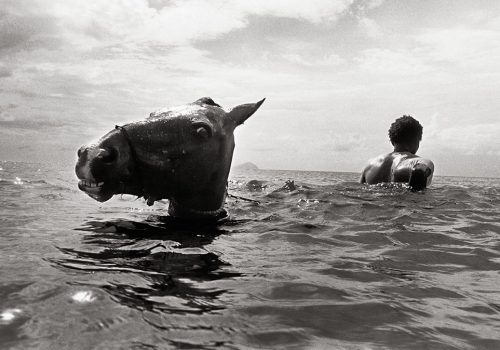For the general public, Andy Summers is the brilliant guitarist and composer of the legendary group The Police, one of the most famous in the world, active between 1977 and 1984. Summers has however built, in parallel to his musical activity, a unique photographic work. According to him, it constitutes the mental and visual counterpart of his music, marked by a complex melodic search, harmonies with rather melancholy, even convulsive colors, mixing jazz, classical guitar, reggae and South American influences. .
Since his beginnings in 1979, Summers has considered his photographic practice as the realization of a diary in pictures. He first photographed the life inside The Police, but from a personal point of view, the guitarist Andy Summers questioning an artistic adventure ending up destabilizing him, making him doubt himself and the artificial world engulf his character / role of “guitar heroe” to the detriment of his personal life .. Self-taught, Summers has forged the eye contacts of the books of the great masters of his new passion, real bulimia to the measure of unparalleled craze , at that time, America for photography, in which bathe its beginnings.
Andy Summers has never hidden his influences, much marked by the documentary practice, Henri Cartier-Bresson to Walker Evans, or the “street photography” then dominant in the 1970s, that of Garry Winogrand and Lee Friedlander, their aesthetics of “upsurge”. The lessons he draws from Robert Frank, whose work fascinates him like his entire generation, Summers absorbs by privileging the personal point of view on the world, the autobiographical dimension. We must add his taste for moody pictures, sometimes treated at home to the limit of the visible, and the fuzziness that ensue. As for the technical simplifications and choices of black and white that Andy Summers accommodates, they are those of classic European photography. To these assumed influences, it is necessary to add the legacy of Ralph Gibson. It was through him, as soon as they met in the early 1980s, that Summers truly tackled formal questions, the conception of serial work, the role of abstraction, or even that of the photographic book as an end.
Andy Summers did it with photography as with his music. Both are forged in the deep knowledge of the masters, then in their creative overtaking.
The nature of the photographic subjects he favors, and which, if we omit his work around the group The Police, exclude any reference to the media and noisy world of “show business”, belongs mainly to this fringe of urban surrealism , so dear to the French surrealist writers, André Breton or Aragon, who explored the fruitful strangeness: activities of the American or Japanese metropolis, fascinating streets of the South American cities … The ex-guitarist of Police, as soon as he engages in photography in 1979, uses until 1984 the extraordinary opportunities of the tours of the group for, as soon as the scene left, rush into the most humble and popular urban nights, so the most mysterious, enjoying a second life, more anonymous and just as rich, if not more so, than that of the rock star he has become.
In the years that follow, and to this day, Summers will be dependent on this double attraction, that of the visual and musical elements, and their possible resolution within the photographic image, of which it fully measures the difficulties of realization, especially in the limits of the image alone. But he will carefully avoid, in his search for transpositions of musical effects towards the visual domain, any experimental heaviness. Hence the recourse, more subtle, to the series, to the book, to the musical performance performed more and more often by improvising on his guitar before the projection of his photographs.
The photographic strangeness so characteristic of Andy Summers’ style touches on the “disturbing strangeness” of which Freud speaks, a feeling of anxiety about a familiar domain suddenly appearing to mask a secret generating anxiety. Summers appears as a nostalgic watchman, eager to subtract the last poetic outbursts or the strange secrets of a world still diversified, recorded before its final liquidation initiated by globalization.
Gilles Mora
Curator of the exhibition
Artistic Director of the Pavillon Populaire.
« Andy Summers. Une certaine étrangeté, photographies 1979-2018 »
February 6 – April 14 2019
Pavillon Populaire // Espace d’art photographique de la Ville de Montpellier
Esplanade Charles-de-Gaulle
34000 Montpellier
https://www.montpellier.fr/506-les-expos-du-pavillon-populaire-a-montpellier.htm
















